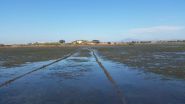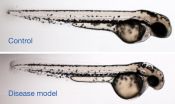(Press-News.org) Magnetic materials form the basis of most hard disc drives as they are able to store data. A team from the University of Sheffield's Faculty of Engineering have been investigating whether they could also be used to perform calculations, and so take on the role of a computer's central processing unit (CPU).
Lead researcher, Dr Tom Hayward, explains: "Magnetic materials are useful for data storage because they can retain information without consuming energy. A computer built around a CPU made of magnetic materials should be much more power efficient than existing technologies, as it should be able to function with minimal energy consumption."
Using computer simulations, the team have shown it is possible to create magnetic 'logic gates', the fundamental building blocks of a CPU, using magnetic materials. The results are published this month in Physical Review Applied.
Dr Hayward says: "In wires of magnetic material, two hundred times thinner than a human hair, magnetism can form into swirling 'tornadoes', known as magnetic vortex domain walls. In our simulations, we use vortices where the magnetism turns clockwise to represent 0 and vortices where it turns anticlockwise to represent 1, allowing us to encode binary data. The vortices are then flowed through the wires using, and interacted with, carefully defined features in the wires that recreate the function of logic gates."
The researchers now plan to build experimental prototypes of the logic gates, and to investigate whether they can be made smaller and to operate faster – critical steps in developing the concept into a usable technology.
Future computers could be built from magnetic 'tornadoes'
2014-10-14
ELSE PRESS RELEASES FROM THIS DATE:
Institutional rearing may increase risk attention-deficit disorder
2014-10-14
Philadelphia, PA, October 14, 2014 – Over the past decades, we have seen numerous tragic examples where the failure of institutions to meet the needs of infants for social contact and stimulation has led to the failure of these infants to thrive.
Infancy and childhood are critical life periods that shape the development of the cortex. A generation of research suggests that enriched environments, full of interesting stimuli to explore, promote cortical development and cognitive function. In contrast, deprivation and stress may compromise cortical development and ...
New discovery will enhance yield and quality of cereal and bioenergy crops
2014-10-14
ST. LOUIS, MO – October 13, 2014 –A team of scientists led by Thomas Brutnell, Ph.D., director of the Enterprise Rent-A-Car Institute for Renewable Fuels at the Donald Danforth Plant Science Center have developed a new way of identifying genes that are important for photosynthesis in maize, and in rice. Their research helps to prioritize candidate genes that can be used for crop improvement and revealed new pathways and information about how plants fix carbon. The findings, published in "Comparative analyses of C4 and C3 photosynthesis in developing leaves of ...
Scientists link ALS progression to increased protein instability
2014-10-14
LA JOLLA, CA—October 13, 2014—A new study by scientists from The Scripps Research Institute (TSRI), Lawrence Berkeley National Laboratory (Berkeley Lab) and other institutions suggests a cause of amyotrophic lateral sclerosis (ALS), also known as Lou Gehrig's disease.
"Our work supports a common theme whereby loss of protein stability leads to disease," said John A. Tainer, professor of structural biology at TSRI and senior scientist at Berkeley Lab, who shared senior authorship of the new research with TSRI Professor Elizabeth Getzoff.
Getzoff, Tainer and ...
Taking infestation with a grain of salt
2014-10-14
Twenty years ago, biologists Kathy Boyer and Joy Zedler, then researchers at San Diego State University, speculated that too many insects feeding on cordgrass in the marshes of San Diego Bay could endanger the grass, and in turn endanger the bay wildlife that relies on it.
Picking up where Boyer and Zedler left off, SDSU biologist Jeremy Long is currently further exploring the dimensions of this relationship. What he's found so far suggests that it's not a simple as saying too many insects spell death for a host plant. Instead, his research suggests a complex interplay ...
Fermented milk made by Lactococcus lactis H61 improves skin of healthy young women
2014-10-14
Philadelphia, PA, October 13, 2014 – There has been much interest in the potential for using probiotic bacteria for treating skin diseases and other disorders. Japanese researchers have now found that milk that has been fermented using a probiotic dairy starter can also benefit the skin of young healthy women, reports the Journal of Dairy Science®.
Probiotics have been defined by the Food and Agriculture Organization-World Health Organization as "live microorganisms which, when administered in adequate amounts, confer a health benefit to the host."
"Although ...
Study reveals how deadly MERS virus enters human cells
2014-10-14
ITHACA, N.Y. – Cornell University researchers have uncovered details of how the deadly Middle East respiratory syndrome coronavirus (MERS-CoV) enters host cells, and offer possible new avenues for treatment.
The study, appearing online this month in the Proceedings of the National Academy of Sciences, discovered that a common protease enzyme known as furin activates the MERS-CoV to fuse with cell membranes and enter host cells.
The researchers, Gary Whittaker, Cornell professor of virology, and Jean Millet, a postdoctoral associate in Whittaker's lab, suggest ...
Turtle tumors linked to excessive nitrogen from land-based pollution
2014-10-14
Hawai'i's sea turtles are afflicted with chronic and often lethal tumors caused by consuming non-native algae "superweeds" along coastlines where nutrient pollution is unchecked. The disease that causes these tumors is considered the leading cause of death in endangered green sea turtles. The new research was just published in the scientific journal PeerJ.
Turtles that graze on blooms of invasive seaweeds end up with a diet that is rich in a particular amino acid, arginine, which promotes the virus that creates the tumors. Scientists at the University of Hawai'i at Mānoa ...
QUT study helps outdoor workers reduce their skin cancer risk
2014-10-14
Skin cancer is one of the biggest fears for one in two outdoor workers and when the boss and staff work together the sun safe message gets through, a QUT study has found.
The study, which found more than 50 per cent of outdoor workers rated UV radiation exposure at work as one of their biggest concerns, also identified how a workplace intervention could improve workers' behaviours and attitudes towards sun protection to reduce their risk of skin cancer.
QUT in collaboration with Cancer Council Queensland and Curtin University worked with 14 Queensland outdoor workplaces ...
Mediterranean diet, olive oil and nuts can help reverse metabolic syndrome
2014-10-14
For people with metabolic syndrome, a Mediterranean diet supplemented with extra-virgin olive oil or nuts may help reverse the condition, indicate findings from a clinical trial published in CMAJ (Canadian Medical Association Journal).
About 25% of adults around the world have metabolic syndrome. The syndrome exists in the presence of three or more factors such as large waist circumference, high blood pressure, low HDL-cholesterol, high levels of triglycerides and high blood sugar concentrations that can increase the risk of diabetes, heart disease and death.
Spanish ...
For one family, zebrafish help provide genetic answers
2014-10-14
Research in zebrafish has helped identify the cause of an unknown genetic disorder affecting a boy and two of his uncles, scientists report in an article published October 14 in the journal Genetics.
The findings demonstrate the growing importance of zebrafish as laboratory models of rare diseases. Such models allow geneticists to make sense of the deluge of candidate disease genes being uncovered by advances in sequencing technologies. Although rare diseases are uncommon individually, together they affect as many as 25 million people in the United States.
The project ...



